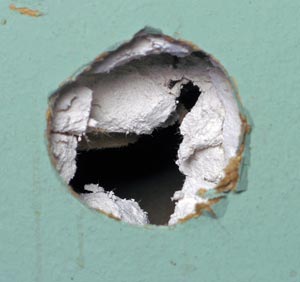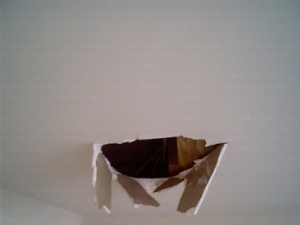The method to use for drywall repairs and patching depends on whether the damage is on a wall or the ceiling. Each repair poses both unique and similar challenges. The wall repairs are best done first, if possible, then the ceiling since they tend to be more involved; don’t be caught on a ladder wondering what to do next without a grasp on the basics, it’s not the time for guesswork. You should first develop the techniques for mudding and taping, basic cuts and hole patches before you tackle more involved projects.
Mudding and Taping
The types of joint compounds are unique in the properties they offer. From hot mud (speed dry) to all-purpose and then for final coating, topping mix. Hot mud will set the cut patch in place and requires taping, which accelerates dry time and makes the repair go quicker. The speed dry mud comes in bagged, powdered form. But it is not intended for final coating. It is mainly used for bedding, curing to the hardest granular set.
Redi-mix, multi-purpose is a bedding and finish compound. When sanding, redi-mix topping compound is ideal. Certain multi-purpose mixes are formulated to shed toward the ground upon sanding, rather than dissipate into the air.
Wall Hole Repair
 Damage to the walls can be caused by moving, by all sorts of accidents or even vandalism. When repairing holes in the wallboard, there are a variety of techniques that can be applied across damaged areas as determined by hole size. For dings and surface repairs there is wall spackling.
Damage to the walls can be caused by moving, by all sorts of accidents or even vandalism. When repairing holes in the wallboard, there are a variety of techniques that can be applied across damaged areas as determined by hole size. For dings and surface repairs there is wall spackling.
Walls that have roughly pencil-sized hole damage are prevalent from mounts and brackets inserted into the drywall. These small holes in the wall can be entirely restored to the eye. Damage of the next approximate increment – hole repairs up to a couple inches across – starts to require taping to prevent cracking and to form structural basis for the compound. This is an important concept for all repairs, mudding and taping.
Board swapping, or replacing the existing with new drywall sections, is the sturdiest fix overall. It provides both the most serviceable surface and amount of deterrence to cracking as compared to other techniques. The materials you have on hand and the extent you wish to go to, to secure a strong patch, will make all the difference – with hole size remaining a significant factor.
The advent of metal patching methods provides another choice for repairing sizable damage.
Ceiling Area Repairs
 Damage to ceilings can be caused by everything from roof leaks to a misplaced foot when walking in the attic. Almost all the skills you have learned from wall repair is applicable to ceilings as well. Keep in mind though that joint compound is notorious for sagging when repairing ceilings. Larger braced ceiling repairs offer durability as do smaller replacements with clips; it’s all a matter of choosing the best method for the repair that is before you.
Damage to ceilings can be caused by everything from roof leaks to a misplaced foot when walking in the attic. Almost all the skills you have learned from wall repair is applicable to ceilings as well. Keep in mind though that joint compound is notorious for sagging when repairing ceilings. Larger braced ceiling repairs offer durability as do smaller replacements with clips; it’s all a matter of choosing the best method for the repair that is before you.
For all patches both ceiling and walls, where there is the element of direct physical wear, like with the changing out bulbs with canned lighting or the constant light force of a hand onto a wall plate, some methods like a mesh tape patch alone for a section of mis-cut drywall — might possibly crack out. Therefore the amount of wear is a factor in deciding which patch method is best suited.
As you can see, there is a lot to know about drywall. This is just the tip of the iceberg. You can read more about drywall repair online at http://drywalltips.org/ or your favorite home improvement website. When you’re ready to get started, drop by the tool library for your supplies.
1 Comment
PompanoBeachPlumber · October 17, 2012 at 4:58 pm
Good stuff, thank you for this. As a contractor this really helps keep me fresh…. Thanks Again…
Comments are closed.